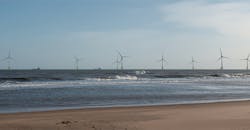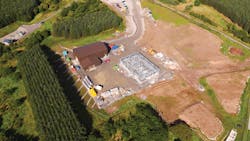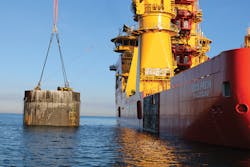Scotland’s largest offshore wind test and demonstration facility, the European Offshore Wind Deployment Centre, was developed by the Vattenfall-owned Aberdeen Offshore Wind Farm Ltd., supported by the Aberdeen Renewable Energy Group. In addition to the energy-generating offshore wind farm, the European Offshore Wind Deployment Centre (EOWDC) project funds one of the largest research programs of its kind to conduct in-depth scientific research and monitoring in a real-time environment.
Located in Aberdeen Bay, this innovative offshore wind project incorporates next-generation technology and supports the industry’s objective to supply competitive clean power from offshore wind farms. The wind farm consists of 11 wind turbines, with a total installed capacity of 92.4 MW, located 2 km to 4.5 km (1.2 miles to 2.8 miles) from the shore.
Two 66-kV, 400-sq mm (0.62-sq inch) stranded copper-core, cross-linked polyethylene (XLPE) insulated alternating-current subsea cables with an embedded fibre-optic cable, consisting of 48 fibers, are connected to the wind turbines installed in these arrays. The 66-kV cables also provide a connection between the offshore wind farm and onshore 132-kV Blackdog Grid substation. This wind farm generates 309 GWh annually, enough to supply the equivalent of 70% of Aberdeen’s domestic electricity demand. EOWDC took the opportunity to incorporate several innovative design and construction features in this project.
Innovative Design
Offshore wind farms using 66-kV array voltages are emerging slowly within the offshore wind sector. Turbine developments in the pipeline today are around 10 MW, but this likely will increase with future developments. The increasing size of wind turbines means the current ratings of 33-kV array cables have a limiting effect on the number of turbines that can be connected to a single cable.
By increasing the voltage from the traditional 33-kV connections to 66 kV, more of the larger turbines can be connected to a single 66-kV cable. Ultimately, this reduces the overall number of arrays and subsequent cabling requirements for a project compared to conventional 33-kV array voltages. Also known as the Aberdeen Offshore Wind Farm, EOWDC is one of the first wind farms to deploy 66 kV as an inter-array voltage.
Study Results
For any new grid-connected wind farm, the project must demonstrate the ability to comply with grid code requirements. TNEI Services Ltd. was involved in conducting several EOWDC system-design studies, and the results unveiled positive outcomes associated with the unique electrical design and reactive power requirements.
The load-flow and fault-assessment studies provided crucial information to assess the full reactive power capability of the wind farm and ascertained whether additional reactive power at the point of common coupling was required. The study also provided useful information to determine the appropriate filter size at the 132-kV level as well as the tapping range required for the 132/66-kV transformer on-load tap-changer.
To fully assess the reactive capability of the 66-kV connected wind farm, TNEI created a purpose-built system model using software packages IPSA and DIgSILENT PowerFactory. The model was designed based on data provided by the developer, Vattenfall AB. The load-flow and fault-level assessments were performed using normal operating and worst-case voltage levels (0.9 pu, 1 pu and 1.1 pu).
It also was shown a static synchronous compensator (STATCOM) was not required for the wind farm design. The results of the load flow displayed strong evidence the wind turbines had enough reactive power capability to achieve grid code compliance for both leading and lagging power factors, without additional reactive power boost.
It was determined the use of harmonic filters likely would have very little impact on the overall system. The study showed a relatively small filter could be used without having to install any compensation equipment. For larger filter sizes, reactive support would be required. However, a simple reactor provides enough support without adding further complexity to the electrical design.
Under zero power conditions, energising the cable without the turbines connected can lead to issues meeting reactive power limits set by National Grid. To overcome this issue, adopting a strategic and staged energisation plan limits the reactive power export under these conditions to within acceptable levels. A staged energisation strategy reduces the need for additional project-specific reactive power support.
Voltage control also is another key operating feature for any grid-connected wind farm and must be demonstrated at the grid entry point. For EODWC, a set of quasi dynamic load-flow studies were performed to assess the performance of the wind farm at the grid entry point and determine whether additional reactive compensation was required to achieve UK Grid Code voltage control requirements. The studies were performed under the conditions of maximum output from the wind farm with initial grid voltages of 0.95 pu and 1.05 pu to simulate extreme scenarios.
These studies highlighted the 66-kV wind farm is capable of meeting reactive power requirements under 2% and 7% step-change conditions at the point of connection. Again, this investigation highlighted further reactive compensation was not required, helping to streamline the overall project design.
The results from the studies undertaken lay the foundation for further 66-kV projects to develop within the industry. They show the reactive compensation needed is not as drastic as initially thought and, in comparison, the reactive power support required is like that of an equivalent 33-kV connected wind farm.
The EOWDC and system design studies provide an excellent example of how to execute a 66-kV wind farm. This should increase confidence in the industry to drive this design principle forward and lead to more 66-kV projects, which likely will become the industry standard for inter-array connections in the foreseeable future.
Construction Details
Through a competitive tendering process that attracted interest from different manufacturers, Aberdeen Offshore Wind Farm Ltd. awarded a contract to MHI Vestas Offshore Wind A/S for the supply of 11 V164-8 MW turbines that have a tip height of 191 m (627 ft). MHI Vestas also was awarded a full-scope service contract for a period of 20 years. JDR Cable Systems will supply the inter-array and export subsea cables from the wind farm.
The contractor for construction and installation of the offshore infrastructure, including the foundations and cabling, was Boskalis.
The scope of this contract involved deployment of one of the world’s largest floating cranes. Positioned in water depths varying from 19 m (62 ft) to 31 m (102 ft), the wind turbines are supported by three-legged suction bucket jacket (SBJ) foundations manufactured by Smulders Projects. These foundations enabled faster offshore installation with minimal noise emission. By reversing the installation process, they can be easily decommissioned. Designed for complex seabed conditions and faster installation, these foundations helped to reduce the cost of offshore wind energy.
The contract for complete construction of the 132-kV grid substation — equipped with 120-MVA, 66/132-kV transformers, including installation of the associated onshore cabling — was awarded to engineering and infrastructure specialist contractor J. Murphy & Sons Ltd.. Scottish Hydro Electric Transmission Ltd. provided the connection from the Aberdeen Wind Farm to the existing 132-kV transmission system.
Timetable & Funding
All project consents were in place by August 2014 and Fugro Geoconsulting Ltd. commenced geophysical surveys of the offshore seabed in fall 2016. Site construction work on the onshore grid substation also started in 2016 with a planned commissioning completion date of spring 2018. Similarly, all offshore construction and cable laying was completed in spring 2018, and the project has been operational since summer 2018.
Vattenfall made its final investment decision (FID) in July 2016, committing £300 million (US$402 million) to the construction of the wind farm. The project also received a £40 million (US$53.6 million) grant from the European Union.
Now, the EOWDC is Scotland’s largest offshore wind test and demonstration facility. Located off Aberdeen Bay, this 92.4-MW, 11-turbine offshore wind farm uses next-generation technologies that make this northeast corner of the UK home to a world-class laboratory of clean energy innovation that helps to drive down the cost of offshore wind energy.
Acknowledgement
The authors thank Natalie Ghazi of Vattenfall for providing the illustrations for this article.
For more information:
Boskalis | https://boskalis.com
DIgSILENT | www.digsilent.de
Fugro Geoconsulting | www.fugro.com
J. Murphy & Sons | www.murphygroup.com
JDR Cables | www.jdrcables.com
MHI Vestas | www.mhivestasoffshore.com
SHET | www.ssen-transmission.com
Smulders Projects | www.smulders.com
TNEI | ww.tneigroup.com
Vattenfall | http://vattenfall.com
About the Author
Lauren McVey
Lauren McVey has a master’s degree in electronic and electrical engineering from the University of Strathclyde. She joined TNEI Services Ltd. as a graduate consultant and has been involved in a variety of projects, from grid connection applications and reviews to power system compliance studies. McVey currently offers support to one of the United Kingdom’s distribution network operators.
Rajat Aggarwal
Rajat Aggarwal has a master’s degree in electrical power systems from the University of Manchester and is a member of Vattenfall AB’s project management team, the developer and owner of the Aberdeen Offshore Wind Farm Ltd. With experience in the design of various electrical systems, he is responsible for the design, construction and commissioning of the wind farm within the specified time scales.



